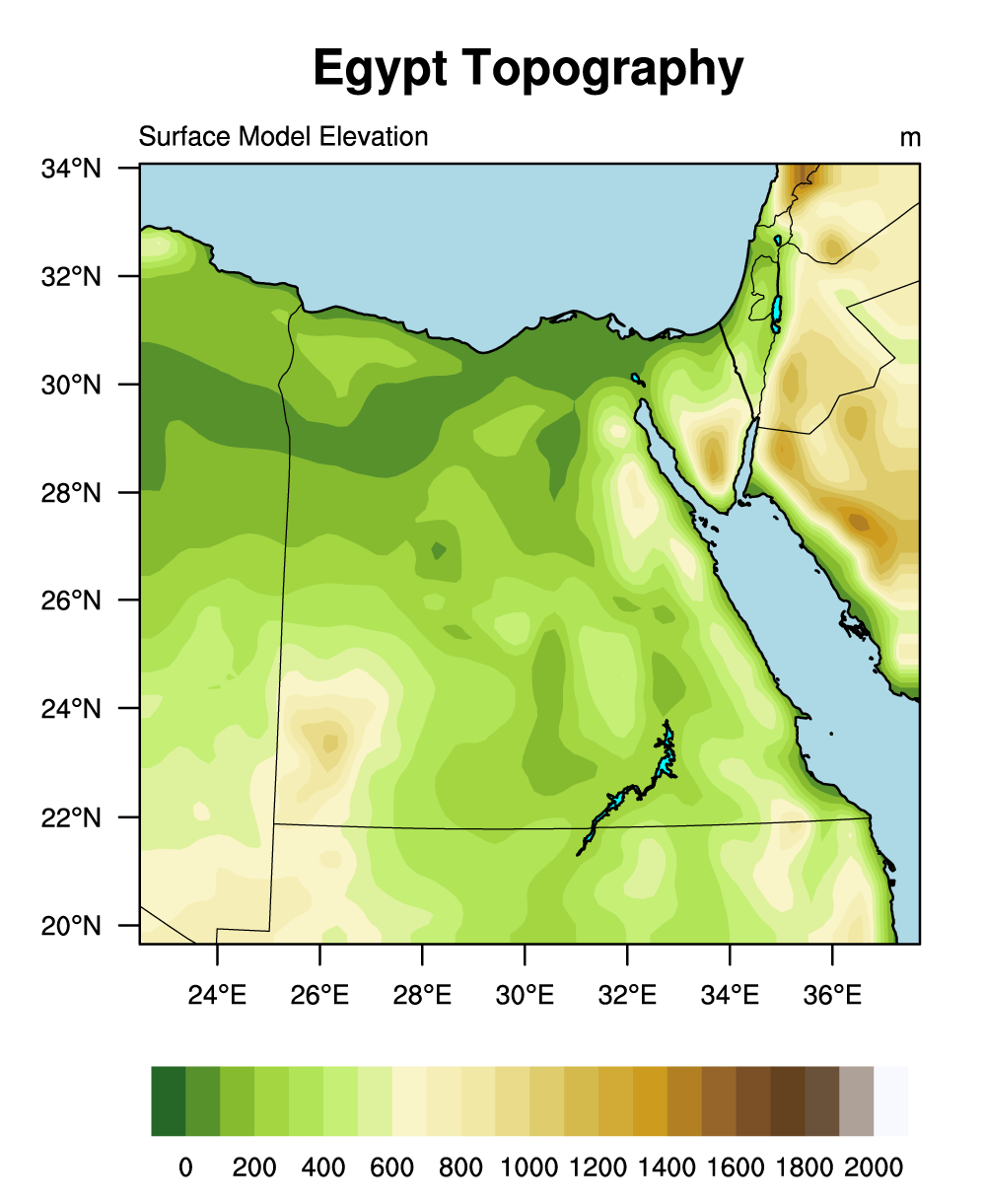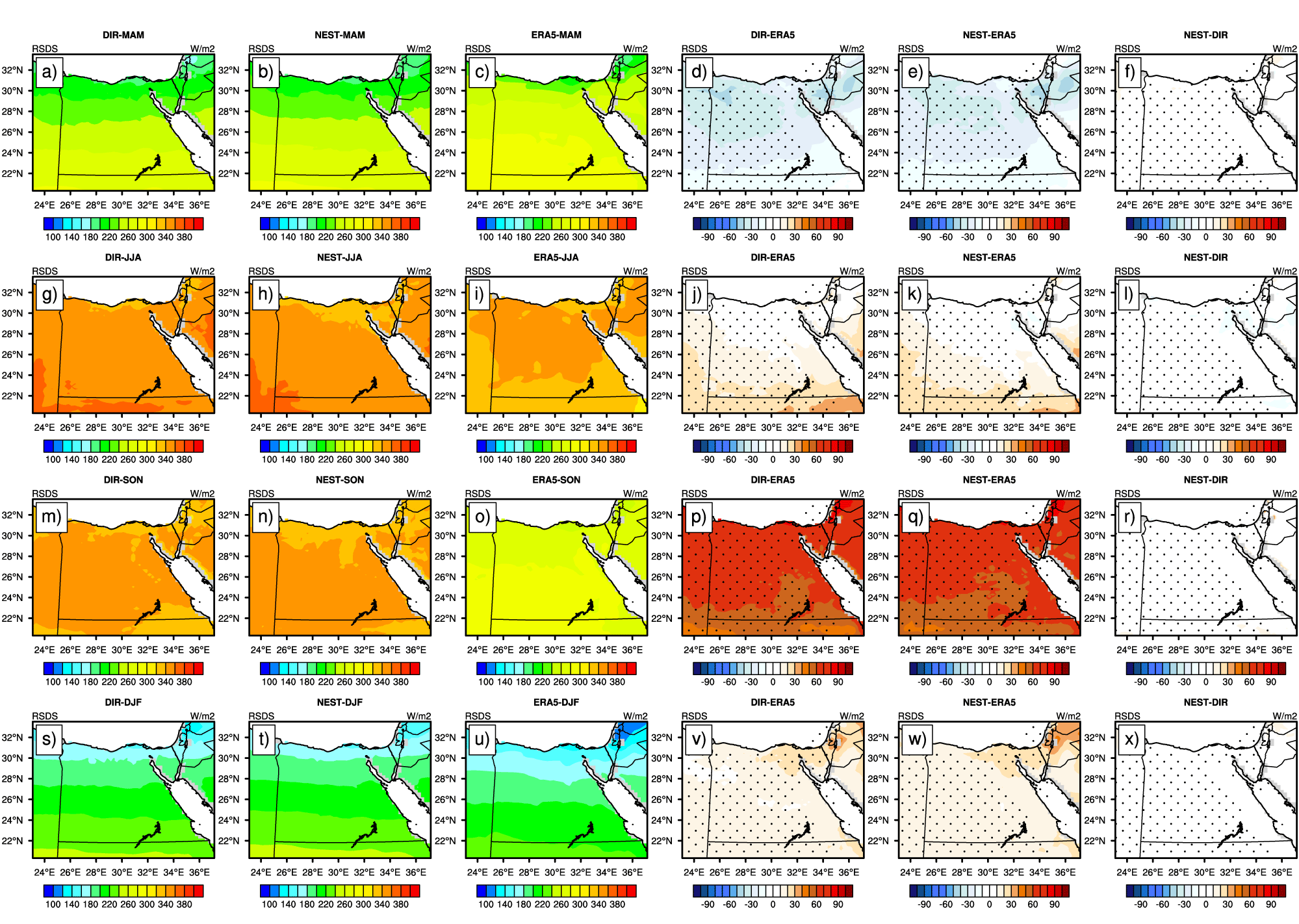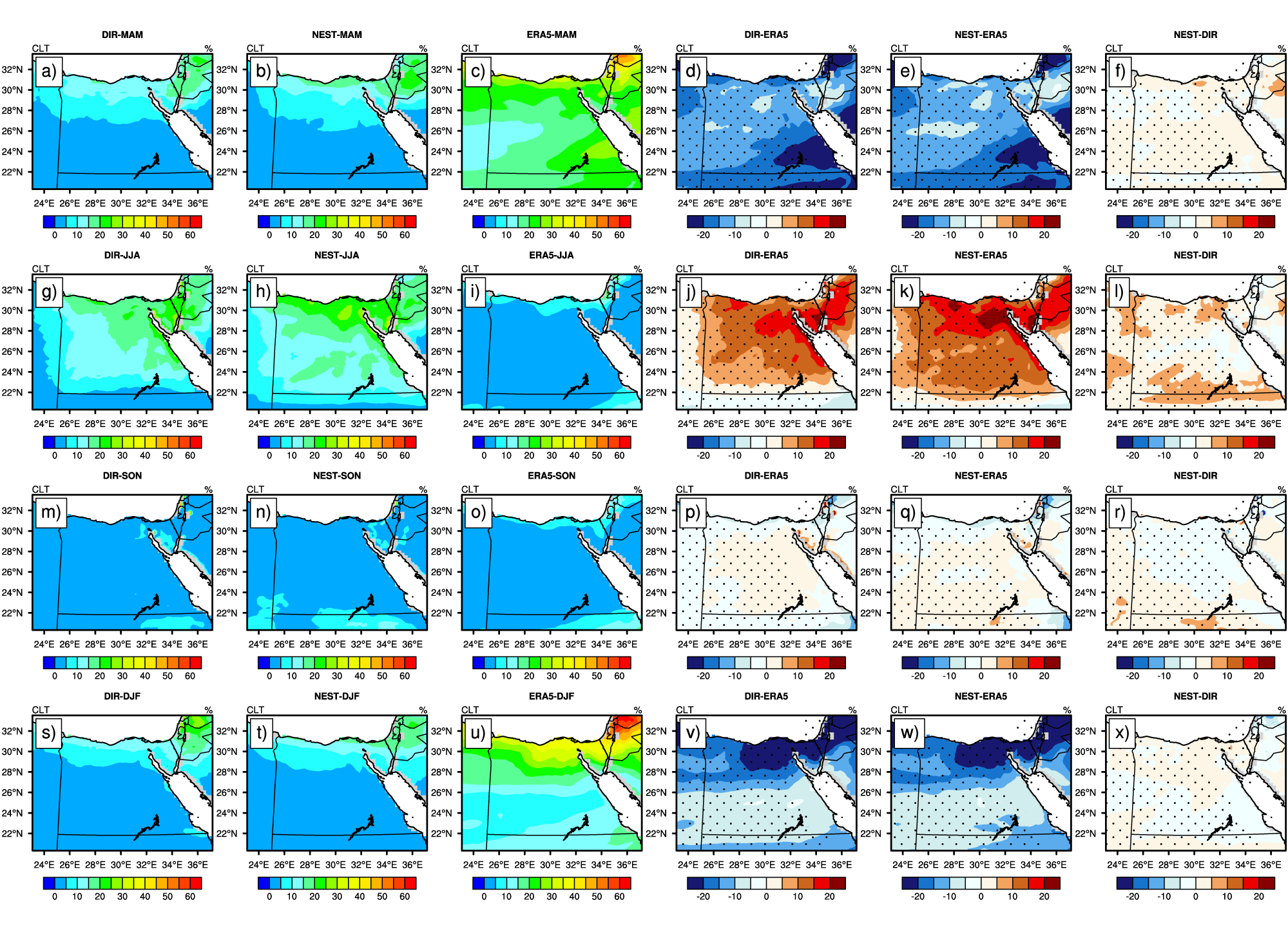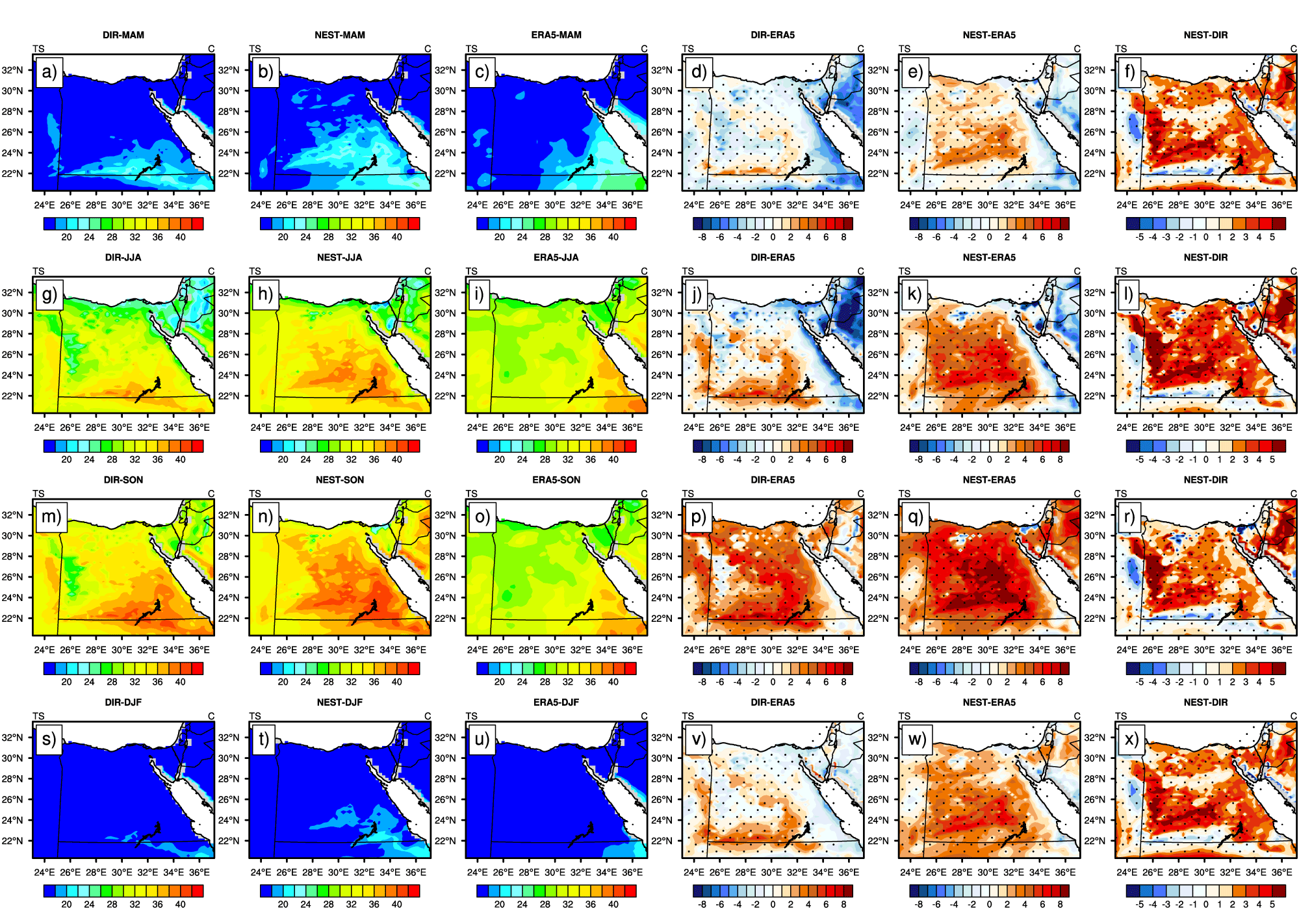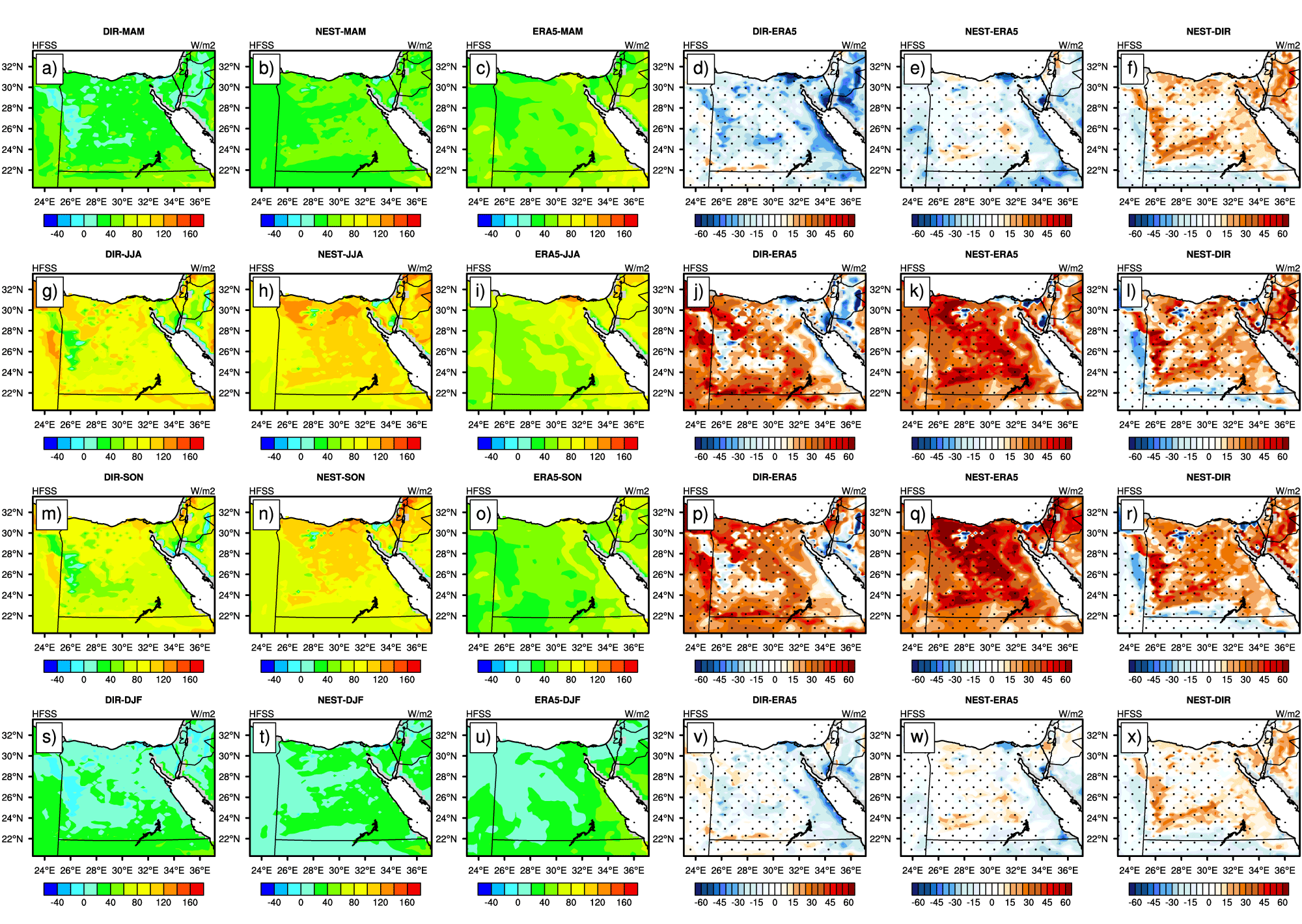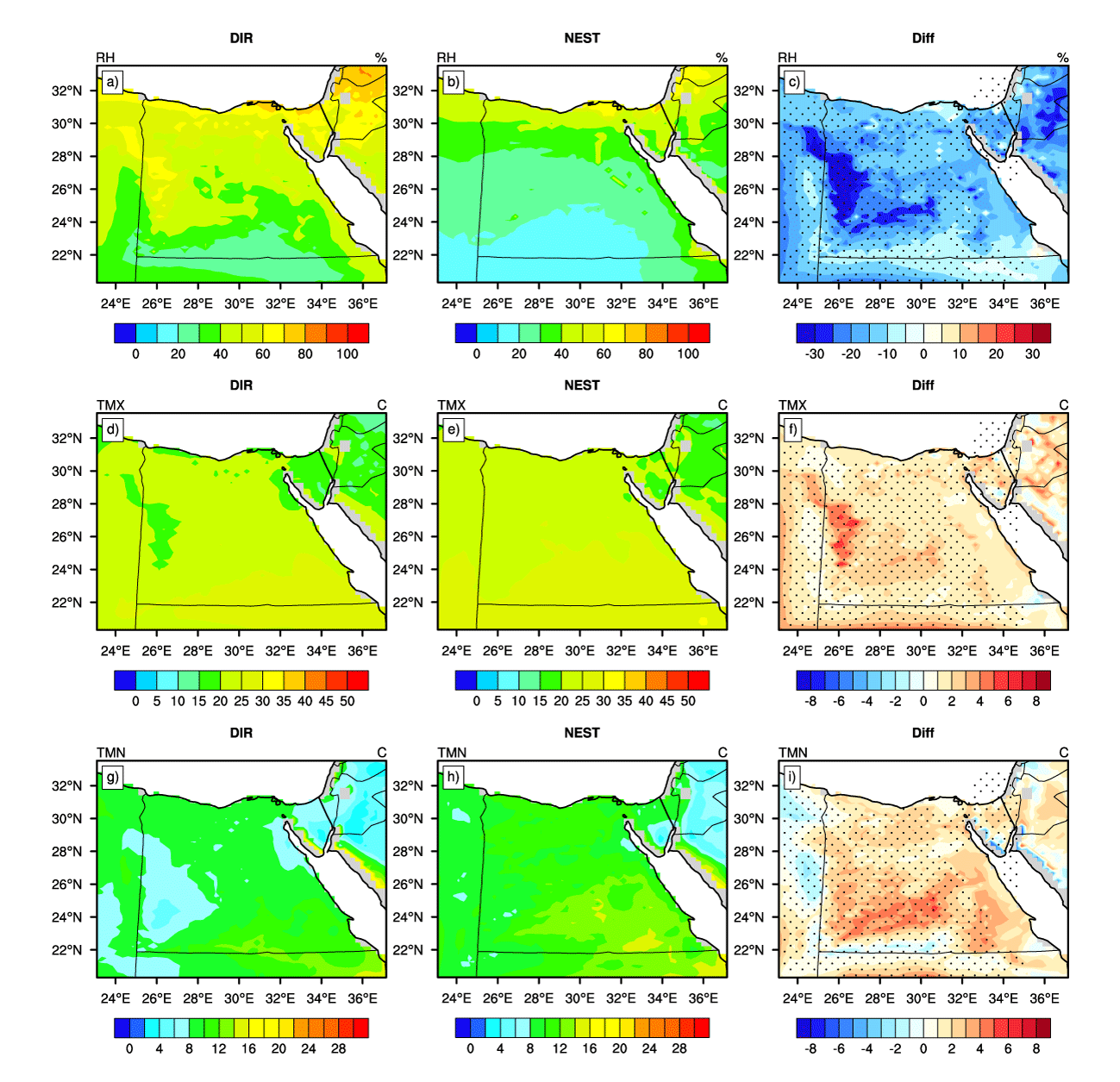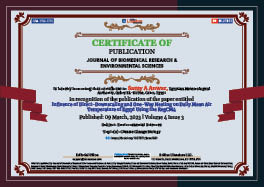Environmental Sciences . 2023 March 09;4(2):338-347. doi: 10.37871/jbres1681.
Influence of Direct-Downscaling and One-Way Nesting on Daily Mean Air Temperature of Egypt Using the RegCM4
Samy A Anwar*
- ERA-Interim
- ERA5
- Nest
- Regional climate model
Abstract
Daily mean air temperature (TMP) is an important indicator for a climate change study and it reflects the daily changes of the maximum and minimum air temperature. Downscaling of a General Circulation Model (GCM) to a regional scale is important to ensure accurate simulation of the TMP. To address this issue, a comparison was conducted between Direct Downscaling (DIR) and one-way nesting (NEST) using a Regional Climate Model (RegCM4) in the period 1997-2017 over Egypt. The ERA-Interim reanalysis of 1.5 degrees (EIN15) was used as the atmospheric forcing to downscale the RegCM4 over Egypt, while the fifth generation ECMWF atmospheric reanalysis was used to evaluate the RegCM4 concerning the Total Cloud Cover (CLT), surface short and longwave radiation fluxes (RSDS and RLDS), ground temperature (TS), sensible heat flux (HFSS) and TMP.
Results showed that there was no difference between DIR and NEST regarding the CLT and RSDS; while the NEST overestimated the RLDS more than the DIR particularly in the summer and autumn seasons in comparison with ERA5. Furthermore, the difference between DIR and NEST can be observed as the NEST overestimated the TS more than DIR in all seasons and in particular the summer and autumn seasons. This noted overestimation propagated to the HFSS explaining the high warm bias in the simulated TMP; which was higher in NEST than DIR. Such findings suggest that DIR was only affected by uncertainty associated with the EIN15. Additionally, this uncertainty was amplified using NEST because the uncertainty of EIN15 first propagated to the mother domain and then from the mother to the nested one. Despite of observed biases, DIR shows promising results more than NEST. Therefore, DIR can be recommended for future climate studies over Egypt.
Introduction
Regional Climate Models (RCMs) provides an excellent way for exploring details cannot be seen by the coarse resolution of the General Climate Models (GCMs). Chen L, et al. [1] reported that large-scale atmospheric circulations can be properly simulated using high-resolution RCMs and an improved physical parameterization. Performance of the RCMs is affected by various factors such as: dynamical core [2], physical parameterization [3], horizontal grid spacing [4], nesting methods [5], and different lateral boundary condition [6]. Concerning the influence of Lateral Boundary Condition (LBC), it has been reported that performance of the RCM is considerably affected by the downscaling technique of the GCM [7] as well as its horizontal resolution [8]. Liu S, et al. [9] believe that RCM (which is driven by LBC with different horizontal grid spacing) can show a considerable performance in comparison with reanalysis product. Additionally, it has been reported that performance of the RCM is not considerably affected by increasing the horizontal resolution of the LBC [10].
Xu X, et al. [11] showed that direct downscaling considerably reduces the bias of the 2 m air temperature and precipitation compared to the two-way nesting technique over central eastern China. Further, the two-way nesting led to positive/negative biases of pressure/ water vapor convergence flux (relative to the direct downscaling) and eventually amplifying the biases of the 2 m air temperature and precipitation. Over Egypt, the authors of [12,13] used the Regional Climate Model (RegCM4) to explore the possible potential effects of climate change on potential evapotranspiration, daily maximum and minimum air temperature of Egypt. In the aforementioned studies, the RegCM4 was downscaled by the Earth System Model of the Max Planck Institute (MPI-ESM; [14]) over the mother domain of the Middle East/North Africa (MENA) region with 50 km horizontal grid spacing and over Egypt as the nested domain with 20 km grid spacing. However, the influence of one-way nesting on the considered variables was not discussed in both papers. In the present study, the following questions will be discussed:
- How do the direct downscaling and one-way nesting affect the performance of the RegCM4 concerning the daily mean air temperature of Egypt?
- What are the possible causes beyond the differences of the two cases?
Answers of these questions can give a clue for the best configuration suitable for future studies over Egypt by examining the following variables: surface downward short and long wave radiation fluxes, surface relative humidity, ground temperature, sensible heat flux, daily maximum, minimum and daily mean air temperature. Section 2 describes the study area and experiment design; section 3 shows the results of the study. Section 4 provides the discussion and conclusion.
Materials and Methods
Experiment design
A brief description about the climate of Egypt is covered by Anwar SA, et al. [12] and Mostafa SM, et al. [13], and information about the model domain is given in section (2.2). In this study, the regional climate model (RegCM; version 4.7; [15]) was used. For short, it is referred to as RegCM4. RegCM4 is designed by the Abdus Salam International Centre for Theoretical Physics (ICTP). Additionally, it has been used to address the influence of climate change on potential evapotranspiration [12] and the influence of land cover changes on the surface climate of Egypt [16]. To examine the potential influence of the direct downscaling and one-way nesting on the atmospheric variables reported in section 1, two experiments were conducted over the period 1997-2017. The two experiments adopted both ERA-Interim reanalysis of 1.5 degrees (EIN15; [17]).
The first simulation (DIR) involves the downscaling of the EIN15 directly to the 25 km grid spacing. Further, the second simulation (NEST) involves the downscaling of the EIN15 to a mother domain (with 75 km grid spacing, 40 grid points in both zonal and meridional directions, centered at latitude 27º and longitude 30º). The atmospheric forcing of the mother domain provides the lateral boundary condition to the nested domain (with 25 km grid spacing and 60 grid points in both zonal and meridional directions, centered at latitude 27º and longitude 30º). The first year was considered as a spin-up to properly initialize the RegCM4 model as in [18,19], so the actual analysis starts at 1998 and ends at 2017. For brevity, only the domain of 25 km horizontal resolution figure 1 is shown. Additionally, the following physical schemes were adopted: Emanuel over land and ocean [20] as the cumulus convection scheme, Rapid Radiation Transfer Model [21] and Holtslag as the boundary layer scheme [22].
Observational data
The fifth generation ECMWF atmospheric reanalysis (ERA5; [23]) was used to evaluate the RegCM4 performance concerning the surface radiation budget (short and longwave fluxes), total cloud cover, ground temperature, sensible heat flux and daily mean air temperature. Another reason to use ERA5 is that its horizontal resolution matches the RegCM4 to minimize the error can occur due to interpolating of the ERA5 on the RegCM4 curvilinear grid. ERA5 is designed by the Copernicus Climate Change Service (C3S) at ECMWF. Furthermore, it provides hourly estimates of a large number of atmospheric, land and oceanic climate variables with 0.25° horizontal grid spacing and 137 vertical levels (up to a height of 80 km). For the purpose of the present study, monthly means were aggregated to the seasonal time scale, the period 1998-2017 was chosen to match the simulation time length and ERA5 is bilinearly interpolated on the RegCM4 curvilinear grid following [18,19]. Please note that the significant bias/difference is calculated using student t-test with α = 0.05.
Results
Influence on surface radiation budget and total cloud cover
In this section, the influence of DIR and NEST on the simulated surface radiation budget (i.e., downward shortwave; RSDS, longwave; RLDS radiation fluxes) and Total Cloud Cover (CLT) is discussed. Figure 2 shows the simulated RSDS (for DIR and NEST) in comparison with the ERA5 reanalysis product for the following seasons: March-April-May (MAM), June-July-August (JJA), September-October-November (SON) and December-October-November (DJF). From figure 2, it can be noted that the RegCM4 is able to capture the spatial pattern of the RSDS with respect to the ERA5 in all seasons. Also, switching between DIR and NEST did not show a notable influence on the simulated RSDS as can be seen in the difference between DIR and NEST. Furthermore, the bias varies with the season. For instance, DIR/NEST underestimates the RSDS by 20-50 Wm-2 over all of Egypt in the MAM season. In the JJA and SON seasons, the RSDS peaked with a range of 320-360 Wm-2 over all of Egypt. However, the situation with the RegCM4 model bias is quite different because the DIR/NEST shows a bias of 10-30 Wm-2 in the JJA season (Figure 2). On the other hand, the bias approaches its maximum range (50-90 Wm-2) in the SON season. Lastly in the DJF season, the bias range is 10-20 Wm-2 approaching 30 Wm-2 over the eastern region (particularly near the Red Sea).
Like the RSDS, there is no remarkable difference between the DIR and NEST concerning the CIT either in comparison with the ERA5 or between themselves. Furthermore, DIR/NEST does not able to capture the spatial pattern of the simulated CLT with respect to the ERA5 in all seasons (Figure 3). Such behavior can explain the noted biases in the MAM, JJA and DJF and it can be attributed to the different schemes of the total cloud cover between the RegCM4 and ERA5. Furthermore, it can be observed that DIR/NEST overestimates the CLT (in the JJA season) more than the other seasons because the JJA season is characterized by high RSDS along with the strong convection activity of the Emanuel scheme and the turbulent activity of the Holtslag boundary layer scheme. Additionally the significant difference between DIR and NEST approaches + 5% in the MAM, SON and DJF seasons and it varies from + 5 to + 10% in the JJA season (Figure 3).
Concerning the RLDS, the RegCM4 shows a good ability to reproduce the spatial pattern with respect to the ERA5 in all seasons (Figure 4). Also, the RegCM4 shows a minimum range of RLDS (240-300 Wm-2) in the MAM and SON seasons and a maximum range of RLDS (340-400 Wm-2) in the JJA and SON seasons. Additionally, DIR/NEST shows a bias of 10-20 Wm-2 approaching 30 Wm-2 in the region of 22-26ºN in the MAM and DJF seasons (Figure 4). On the other hand, RegCM4 bias approaches its maximum range as DIR shows a bias of 10-25 Wm-2; while the NEST shows a range of 15-45 Wm-2 in the JJA season. Approximately, the significant difference between NEST and DIR is 10-25 Wm-2 in the JJA season. In the SON season, DIR overestimates the RLDS by 10-30 Wm-2 and NEST overestimates the RLDS by 10-40 Wm-2 compared to ERA5 product. Furthermore, the significant difference between NEST and DIR approaches 10 Wm-2 (Figure 4).
Influence on ground temperature and sensible heat flux
Betts AK, et al. [24] defined the ground temperature (TS) as physical temperature of the Earth's surface; which controls the heat transfer from the earth surface to the adjacent atmospheric layers. Indeed, TS controls the sensible heat flux and daily maximum, minimum and mean air temperature. Moreover, TS is affected by absorption of the incident solar (during daytime) and longwave radiation (during daytime and nighttime). Therefore, it is expected that DIR/NEST considerably affects both the TS and the sensible heat flux (HFSS). Figure 5 shows the simulated TS (for DIR/NEST) with respect to the ERA5. From figure 5, it can be noted that the RegCM4 is able to reproduce the TS pattern compared to the ERA5 in all seasons For instance in the MAM, it can be observed that DIR underestimates the TS along the north, east coasts and in particular the Red Sea coast (by 2-5ºC) and overestimates the TS in the region of 22-26ºN (by 1-5ºC). On the other hand, reduces the noted cold bias of the coasts (1-3ºC) and overestimates the TS over majority of Egypt by 1-6ºC. Qualitatively, NEST is warmer than DIR by 2-5ºC.
In the JJA season, DIR majorly overestimates the TS by 1-5ºC, while NEST overestimates the TS by 3-7ºC in comparison with the ERA5. From a qualitative point of view, NEST is warmer than DIR by 2-5ºC. Furthermore, the bias of DIR/NEST approaches its maximum value in the SON season as DIR shows a bias of 3-6ºC; while NEST shows a bias of 4-8ºC overall of Egypt. Also, the significant difference between NEST and DIR ranges from 2 to 5ºC. Finally in the DJF season, DIR shows a bias of 1-4ºC and NEST shows a bias of 2-7ºC. Qualitatively, NEST is warmer than DIR by 2-5ºC (Figure 5). This noted behavior in the TS can be partially attributed to the high rates of the short and longwave radiation fluxes (particularly in the JJA and SON seasons; see (Figures 2,4). Also, it can be noted that NEST amplifies the bias (relative to the DIR) in comparison with the ERA5. Therefore, TS bias (either from DIR/NEST) propagates to the simulated HFSS.
Figure 6 shows the simulated HFSS with respect to the ERA5. From figure 6, it can be observed that the RegCM4 shows a good ability to reproduce the spatial pattern of the HFSS in all seasons. However, the model bias varies with the season. For instance in the MAM season, DIR underestimates the HFSS by 15-35 Wm-2 (and by 45-60 Wm-2 along the Red Sea coast. On the other hand, NEST underestimates the HFSS by 15-25 Wm-2. Qualitatively, NEST has higher HFSS (by 15-35 Wm-2) than DIR. In the JJA and SON seasons the situation is different because DIR overestimates the HFSS by 15-35 Wm-2 approaching to 40-60 Wm-2 in some regions while NEST overestimates the HFSS by 25-60 Wm-2 over all of Egypt. From a qualitative point of view, NEST is higher than DIR by 15-35 Wm-2 approaching 45 Wm-2 in some regions. Lastly in the DJF season, DIR underestimates the HFSS by 15-25 Wm-2 over majority of Egypt, while NEST overestimates the HFSS. Qualitatively, NEST is higher than DIR by ~10-30 Wm-2 (Figure 6). The noted biases (particularly in the JJA and SON seasons), can be attributed to biases propagating from the RLDS and TS. Such behavior is reflected in the simulated 2 m relative humidity (RH), daily maximum and minimum air temperature (TMX and TMN respectively). This point is covered in section 3.3 to understand the causes beyond the biases of the daily mean air temperature (TMP; section 3.4).
Influence on surface relative humidity, daily maximum and minimum air temperature
In this section, the potential influence of DIR/NEST on the surface Relative Humidity (RH), daily Maximum Air Temperature (TMX) and daily Minimum Air Temperature (TMN) is examined to explore the possible causes beyond such effects. For brevity in analysis, the potential effects of DIR/NEST on the RH, TMX and TMN are examined for the period 1998-2017.
From figure 7, it can be observed that NEST induces a decrease in the RH relative to the DIR by 10-30%. Such decrease can be attributed to increase of the TS relative to the DIR Figure 5). As a result, decrease of RH leads to inducing of a warming effect which explains why the NEST is warmer than DIR concerning the TMX and TMN (Figures 7). Additionally, NEST is warmer than DIR due to increase of RLDS, TS and HFSS (particularly in the JJA and SON). A simple flowchart can demonstrate the mechanism beyond the influence of NEST on the simulated RH, TMN and TMX (relative to DIR):
Increase of TS + increase of HFSS + decrease of RH + increase of RLDS -> increase of TMX and TMN.
Influence on daily mean air temperature
Figure 8 shows the simulated TMP in comparison with the ERA5. From figure 8, it can be noted that the RegCM4 is able to reproduce the spatial pattern of the TMP concerning the ERA5 in all seasons. Furthermore, the RegCM4 model bias varies with the season. For instance, DIR overestimates the TMP by 1-3°C in the MAM season, while NEST overestimates the TMP by 1-5°C when it is compared with ERA5. From a qualitative point of view, NEST is warmer than DIR by 2-4°C. In the JJA season, DIR has a bias of 1-4°C. On the other hand, NEST has a bias of 2-7°C in majority of Egypt. Additionally, NEST is warmer than DIR by 2-5°C. Both DIR/NEST shows a high warm bias with respect to the ERA5 because DIR has a bias of 3-6°C; while NEST has a bias of 5-8°C. Qualitatively, NEST is warmer than DIR by 2-5°C.
Finally in the DJF season, DIR has a bias of 1-4°C and NEST shows a bias of 2-7°C. Like SON season, NEST is warmer than DIR by 2-5°C (Figure 8). It can be noted that NEST amplifies the TMP bias (relative to DIR) in all seasons particularly in the JJA and SON. This noted behavior can be attributed to overestimation of the RLDS, which contributes to warming of the ground surface. Furthermore, the noted impact of NEST is observed in overestimating the TS (more than DIR) in comparison with the ERA5. This overestimation propagates to the simulated HFSS, and eventually the TMX, TMN and TMP.
Discussion and Conclusion
Regional Climate Model (RCM) is an important tool to simulate the meteorological variables (e.g., temperature) on a regional scale. Performance of the RCM is affected by various factors such as: ability to capture the topography features, physical parameterization, Lateral Boundary Condition (LBC) and the horizontal resolution of the LBC itself. Studied the impact of LBC with a various horizontal grid spacing, direct downscaling and one-way nesting to a common horizontal resolution on surface climate over central-eastern China using the Regional Climate Model (RegCM) version 4.6. They found that LBC with various horizontal grid spacing does not induce a considerable impact on the simulated temperature and precipitation. Additionally, the direct downscaling outperforms the one-nesting because the direct downscaling shows a lower bias than the one-way-nesting when it is compared with the reanalysis products. Also, Anwar SA, et al. [12] and Ali AH et al., [16] used the RegCM4 model to downscale the MPI-ESM-MR global climate model over the MENA region with 50 km and then the lateral boundary condition of the MENA domain was used to conduct a one-way nesting over Egypt with 20 km grid spacing to explore the potential effects of climate change on the simulated potential evapotranspiration, land-use changes on the surface climate and daily maximum and minimum air temperature under different future scenarios. However, the potential effects of direct downscaling and one-way nesting on the daily maximum, minimum and mean air temperature of Egypt were not conducted until the present day.
In this study, the Regional Climate Model (RegCM4) was used to address the potential influence of direct downscaling (DIR) and one-way nesting (NEST) on the maximum, minimum and mean air temperature of Egypt using ERA5 reanalysis product as the observational dataset. To accomplish this task, two experiments were conducted over Egypt in the period 1997-2017. In the first experiment, the RegCM4 was directly downscaled by the ERA-Interim of 1.5 degrees (EIN15) to 25 km horizontal grid spacing; while the second experiment involves the downscaling of EIN15 to a mother domain of 75 km horizontal resolution, then it is nested to a 25 km grid spacing. To address the physical mechanism beyond the potential influence of DIR/NEST on the daily maximum, minimum and mean air temperature, the following variables were examined: RLDS, RSDS, CLT, TS, HFSS and RH. The results of the present study can be summarized in the following points:
- There is no significant difference concerning the CLT and RSDS, only RLDS is affected.
- DIR/NEST shows a notable impact on the simulated TS, HFSS, RH, TMX, TMN and eventually the TMP.
- NEST amplifies the simulated bias of the simulated RLDS, TS, HFSS and TMP (with respect to the ERA5) when it is compared with DIR.
Despite of the noted biases in DIR, it outperforms the NEST in comparison with the ERA5 particularly in the JJA and SON seasons in agreement with the results reported by Xu X, et al. [11]. Therefore, DIR can be recommended for future studies concerning the impact of the climate change on the surface climate of Egypt following [18,19]. Furthermore, to ensure a better performance of the DIR, additional sensitivity studies are needed concerning the cumulus convection and boundary layer schemes as well as using various bias-correction techniques following [13].
Author Contributions
Conceptualization, Anwar SA; methodology, Anwar SA.; software, Anwar SA; validation, Anwar SA; formal analysis, Anwar SA; investigation, Anwar SA; resources, Anwar SA; data curation, Anwar SA; writing—original draft preparation, Anwar SA; writing review and editing, Anwar SA; visualization, Anwar SA; supervision, Anwar SA; project administration, Anwar SA. All authors have read and agreed to the published version of the manuscript.
Acknowledgment
Egyptian Meteorological Authority (EMA) is acknowledged for providing the computational power to conduct the model simulations. ECWMF is acknowledged for providing the ERA5 reanalysis product from the web link https://cds.climate.copernicus.eu/ (accessed on 05 February 2023).
References
- Chen L, Huang G, Wang X. Projected changes in temperature, precipitation, and their extremes over China through the RegCM. Clim Dyn. 2019;53(9):5859-5880. doi: 10.1007/s00382-019-04899-7.
- Adeniyi MO. Sensitivity of two dynamical cores in RegCM4.7 to the 2012 intense rainfall events over West Africa with focus on Lau, Nigeria. Int J Simul Model. 2020;40(5):355-365. doi: 10.1080/02286203.2019.1641777.
- Gu H, Yu Z, Richard PW, Wang X. Sensitivity studies and comprehensive evaluation of RegCM4.6.1 high-resolution climate simulations over the Tibetan Plateau. Clim Dyn. 2020;54(7-8):3781-3801. doi: 10.1007/s00382-020-05205-6.
- Gao XJ, Shi Y, Han Z, Wang M, Giorgi F, Zhang D, Xu Y, Giorgi F. Performance of RegCM4 over major river basins in China. Adv Atmos Sci. 2017;34(4):441-455. doi: 10.1007/s00376-016-6179-7.
- Denis B, Laprise R, Caya D, Côté J. Downscaling ability of one-way nested regional climate models: The big-brother experiment. Clim Dyn. 2002;18(8):627-646. doi: 10.1007/s00382-001-0201-0.
- Leps N, Brauch J, Ahrens B. Sensitivity of limited area atmospheric simulations to lateral boundary conditions in idealized experiments. J Adv Model Earth Syst. 2019;11(8):2694-2707. doi: 10.1029/2019MS001625.
- Denis B, Laprise R, Caya D. Sensitivity of a regional climate model to the resolution of the lateral boundary conditions. Clim Dyn. 2003;20(2-3):107-126. doi: 10.1007/s00382-002-0264-6.
- Seth A, Rauscher SA, Camargo SJ, Qian JH, Pal JS. RegCM3 regional climatologies for South America using reanalysis and ECHAM global model driving fields. Clim Dyn. 2007;28(5):461-480. doi: 10.1007/s00382-006-0191-z.
- Liu S, Liang XZ, Gao W, He Y, Ling T. Regional climate model simulations of the 1998 summer China flood: Dependence on initial and lateral boundary conditions. Open Atmospheric Sci J. 2011;5(1):96-105. doi: 10.2174/1874282301105010096.
- Meng C, Ma Y, Ma W, Xu Y. Modeling of a severe winter drought in eastern china using different initial and lateral boundary forcing datasets. Theor Appl Climatol. 2018;133(3):763-773. doi: 10.1007/s00704-017-2217-3.
- Xu X, Huang A, Huang Q, Zhang Y, Wu Y, Gu C, Cai S, Zhu X. Impacts of horizontal resolution of the lateral boundary conditions and downscaling method on the performance of RegCM4.6 in simulating the surface climate over central-eastern China. Earth Space Sci. 2022;9:e2022EA002433. doi: 10.1029/2022EA002433.
- Anwar SA, Salah Z, Khaled W, Zakey AS. Projecting the potential evapotranspiration in Egypt using a high-resolution Regional Climate Model (RegCM4). Environ Sci Proc. 2022;19:43. doi: 10.3390/ecas2022-12841.
- Mostafa SM, Anwar SA, Zakey AS, Wahab MMA. Bias-correcting the maximum and minimum air temperatures of Egypt using a high-resolution Regional Climate Model (RegCM4). Eng Proc. 2023;31:73. doi: 10.3390/ASEC2022-13852.
- Stevens B, Giorgetta M, Esch M, Mauritsen T, Crueger T, Rast S, Salzmann M, Schmidt H, Bader J, Block K, Brokopf R, Fast I, Kinne S, Kornblueh L, Lohmann U, Pincus R, Reichler T, Roeckner E. Atmospheric component of the MPI-M earth system model: ECHAM6. J Adv Model Earth Syst. 2013;5:146-172. doi: 10.1002/jame.20015.
- Giorgi F, Coppola E, Solmon F, Mariotti L, Sylla MB, Bi X, Elguindi N, Diro GT, Nair VS, Giuliani G, Turuncoglu UU, Cozzini S, Güttler I, O’Brien T, Tawfik AB, Shalaby A, Zakey AS, Steiner AL, Stordal F, Sloan LC, Brankovic C. RegCM4: Regional Climate Model description and preliminary tests over multiple CORDEX domains. Clim Res. 2012;52:7-29.
- Ali AH, Salah Z, Anwar SA, Zakey AS. Influence of agricultural activity on the surface climate of new delta of Egypt using the RegCM4. Eng Proc. 2023;31:43. doi: 10.3390/ASEC2022-13763.
- Dee DP, Uppala S, Simmons A, Berrisford P, Poli P, Kobayashi S, Andrae U, Magdalena, Alonso B, Balsamo G, Bauer P, Bechtold P, Beljaars ACM, van de Berg L, Bidlot, Bormann N, Delsol C, Dragani R, Fuentes M, Geer A, Haimberger L, Healy S, Hersbach H, Hólm E, Isaksen L, Kållberg PW, Köhler M, Matricardi M, McNally A, Monge-Sanz BM, Morcrette JJ, Peubey C, de Rosnay P, Tavolato C, Thépaut JN, Vitart F. The ERA‐Interim reanalysis: Configuration and performance of the data assimilation system. Q J R Meteorol. Soc. 2011;137:553-597.
- Anwar SA, Mamadou O, Diallo I, Sylla MB. On the influence of vegetation cover changes and vegetation-runoff systems on the simulated summer potential evapotranspiration of tropical Africa using RegCM4. Earth Syst Environ. 2021;5:883-897. doi: 10.1007/s41748-021-00252-3.
- Anwar SA, Diallo I. Modelling the tropical African climate using a state-of-the-art coupled regional climate-vegetation model. Clim Dyn. 2022;58:97-113. doi: 10.1007/s00382-02-05892-9.
- Emanuel KA. A scheme for representing cumulus convection in large-scale models. J Atmos Sci. 1991;48(21): 2313-2335.
- Clough SA, Shephard MW, Mlawer EJ, Delamere JS. Atmospheric radiative transfer modeling: a summary of the AER codes. J Quant Spectrosc Radiat Transfer. 2005;91:233-244.
- Holtslag AAM, Boville BA. Local versus nonlocal boundary layer diffusion in a global model. J Clim. 1993;6: 1825-1842.
- Hersbach H, Bell B, Berrisford P, Hirahara S, Horányi A, Muñoz SJ, Nicolas J, Peubey C, Radu R, Schepers D, Simmons A, Soci C, Abdalla S, Abellan X, Balsamo G, Bechtold P, Biavati G, Bidlot J, Bonavita M, Chiara GD, Dahlgren P, Dee D, Diamantakis M, Dragani R, Flemming J, Forbes R, Fuentes M, Geer A, Haimberger L, Healy S, Hogan RJ, Hólm E, Janisková M, Keeley S, Laloyaux P, Lopez P, Lupu C, Radnoti G, Rosnay Pd, Rozum I, Vamborg F, Villaume S, Thépaut JN. The ERA5 global reanalysis. Q J R Meteorol Soc. 2020;146:1999-2049.
- Betts AK, Ball JH, Beljaars ACM, Miller MJ, Viterbo PA. The land surface-atmosphere interaction: A review based on observational and global modeling perspectives. J Geophys Res. 1996;101:7209-7225.
Content Alerts
SignUp to our
Content alerts.
 This work is licensed under a Creative Commons Attribution 4.0 International License.
This work is licensed under a Creative Commons Attribution 4.0 International License.





